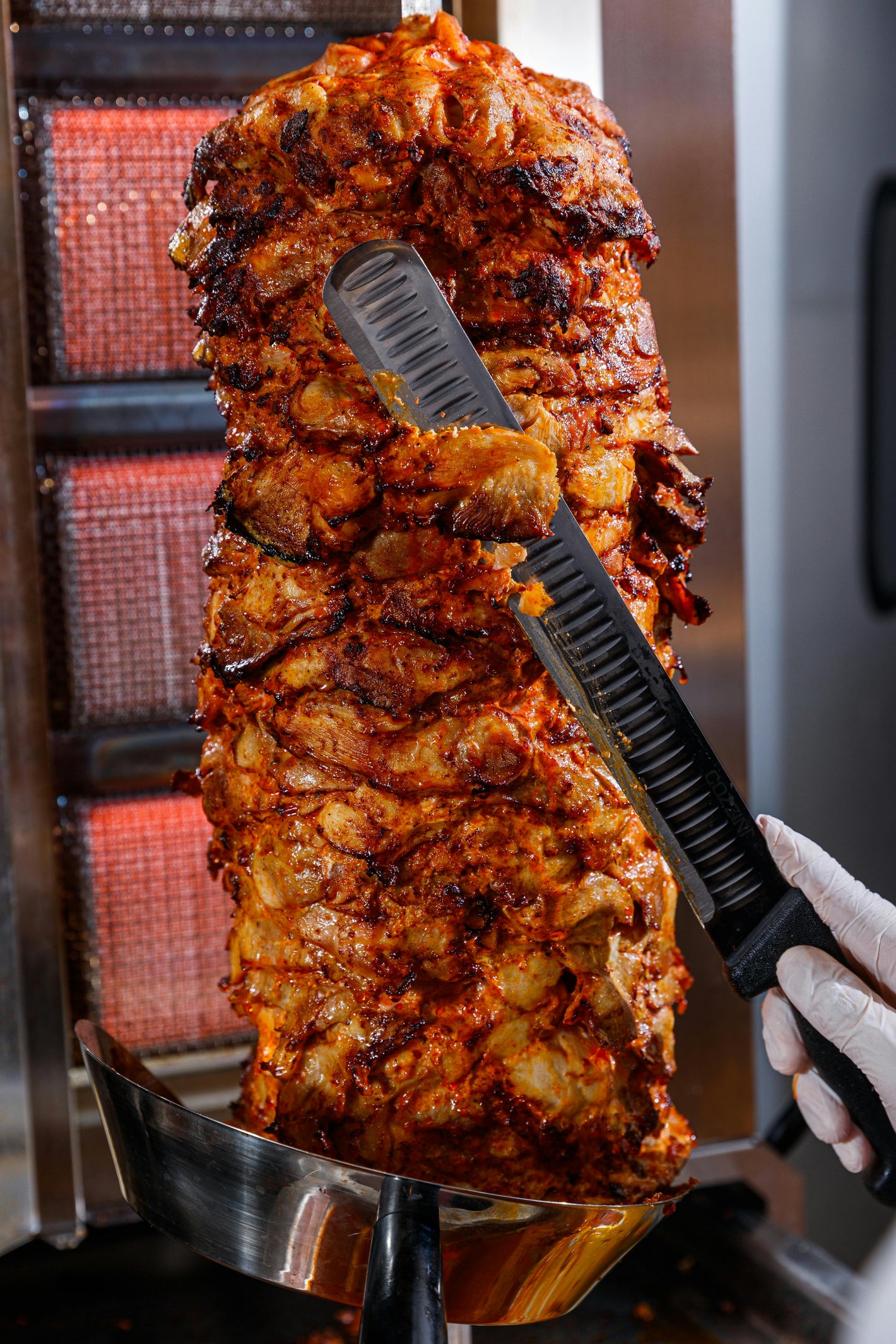Is Doner Meat Healthy?


Doner meat is a tempting fast food in many countries across the globe. The idea of this staple originated in Bursa in the 19th century and is now savoured in many places by meat loving people. It is made of both beef and lamb. In the article below, we will discuss the nutritional aspects and health elements of doner kebab to understand the dilemma surrounding this food.
Doner meat is made from a combination of various types of seasoned meat that is made to stack and rotate on a vertical rotisserie. The concept of Doner meat originated from Turkey and the traditional meat used was that of lamb. Chicken and beef are also commonly used but not popularly consumed. Doner meat holds rich cultural heritage that is favoured in many countries today.

As the Doner Meat is made to rotate and well-cooked, the meat is sliced off in pieces or shreds. These pieces are served alongside Naan or wrapped in a sandwich with sliced vegetables and sauces. The soft and juicy texture of doner kebab is delicious and holds great culinary appeal.
Doner kebab is a combination of various macronutrients. It is loaded with proteins due to its excessive meat content. High protein is essential for muscle growth and repair in individuals engaged in regular intensive workouts. Moreover, doner kebab are also rich in fats as the meat of lambs has fatty depositions as well. This high fat raises nutritional concern that warns its consumers to consider small portions of their food plate for doner kebab.

Doner kebabs are often wrapped in or served alongside a whole-meal pita bread that contain complex carbohydrates and often exceed the recommended daily calorie intake when consumed in this popular combination.
Doner kebab wraps contain vegetables dressings, sauces, fats, cheese, and salts that also has significant impacts on the nutritional profile of this dish. It is particularly advised to consume such wraps with great care in individuals with cardiac health issues, hypertension, and metabolic disorders.
The caloric content of doner kebab is significantly high as discussed by the British Nutrition Foundation (BNF). A single portion of doner kebab is quite filling as it is rich in proteins and fats. It is important to understand and practice moderate and occasional consumption of doner kebab to both savour its deliciousness and dodge possible health outcomes at the same time.
The discussion on health considerations of doner kebab not only limits to the nutritional profile but also the hygiene maintenance during its preparation. Reports of foodborne infections from various customers highlights the importance of proper handling and storage of the doner meat as meat acts as a habitat for various bacterial infections when not handled in a clean environment.
Food outlets of doner kebab often claim that the doner kebab is solely composed of lamb meat. It is often a false claim since investigations show inclusion of chicken or beef as well. The choice of meet is not an issue if it contains lamb meet, chicken, or beef but even traces of pork in doner kebab must face backlash as Jews and Muslims may consume the forbidden pork (on religious grounds) unknowingly.

It is imperative to consider the method of preparation, inquire the seasoning and the cooking techniques. These factors significantly influence the health needs and goals. Traditionally, doner kebab contain high sodium as chef adds liberal doses of salt to the meat for added flavour. This threatens the health of individuals with cardiac health issues and hypertension. Such individuals are advised to give special instructions to the chef before the making of doner kebab. Moreover, it is advised to set a considerable potion for doner kebab in plate as excessive or regular consumption must significantly impair the overall health.
The UK’s Food Standards Agency lead research in 2006 that carefully investigated the doner meat. The study suggested that 18.5% of the doner takeaways raised a threat to the public health. The officers also discovered that the doner meat was loaded with 22% fat and around 12 grams of salt which is the double of recommended daily intake by the healthcare experts. The health concerns and its awareness increased regarding the doner meat, and most experts condemned its consumption.
In the wake of such circumstances, the doner meat industry revolutionized and responded to these health concerns by making changes in the original doner meat style. It included options such as leaner meat slices with minimal salt seasoning and using wholegrain wraps for wrapping the doner meat. The aim and purpose of this evolution is to savour Doner Meat without feeling guilty over selling health or compromising the overall well-being.
What is the recommended portion size for Doner Meat in a balanced diet?
The recommended portion size varies from an individual to another based on their age, built, daily calorie intake and health status. Generally, a serving of 4-5 ounces is advised to maintain a balanced diet without compromising or posing risk to the health. It is important to practice moderation in intake of doner meat as the saturated fats often mess with the cardiac health by depositing itself in the major arteries of the heart (coronary arteries).
What are the health risks associated with consumption of Doner Meat?
The high fat and sodium content in doner meat pose significant threat to overall health and well-being. It links directly to a high level of low density lipoprotein (LDL) that tends to deposit in the arteries, block the blood flow and deprive the destination organ from regulation. This outcome is debilitating as reduced blood flow to brain or heart often manifests as stroke or cardiac attack respectively. Healthcare experts advise mindful consumption of doner meat to dodge concerning medical conditions.
Doner meat or doner kebab originated from Bursa in the 19th century that is now widely consumed and favoured in all parts of the world. The traditional roots and methods of preparation of doner meat lies in Turkey. It is a tempting staple that is best served when wrapped in a bread or served alongside vegetables. Doner meat is a rich source of proteins and fats that is favoured and savoured mostly by men. The high fat content or consumption with white pita bread is a health concern that is now met with alternatives and evolutions in the doner meat. It is important to consider the conditions, method, and technique of preparation of doner meat at the food outlets before consuming it.









Plus get the inside scoop on our latest content and updates in our monthly newsletter.